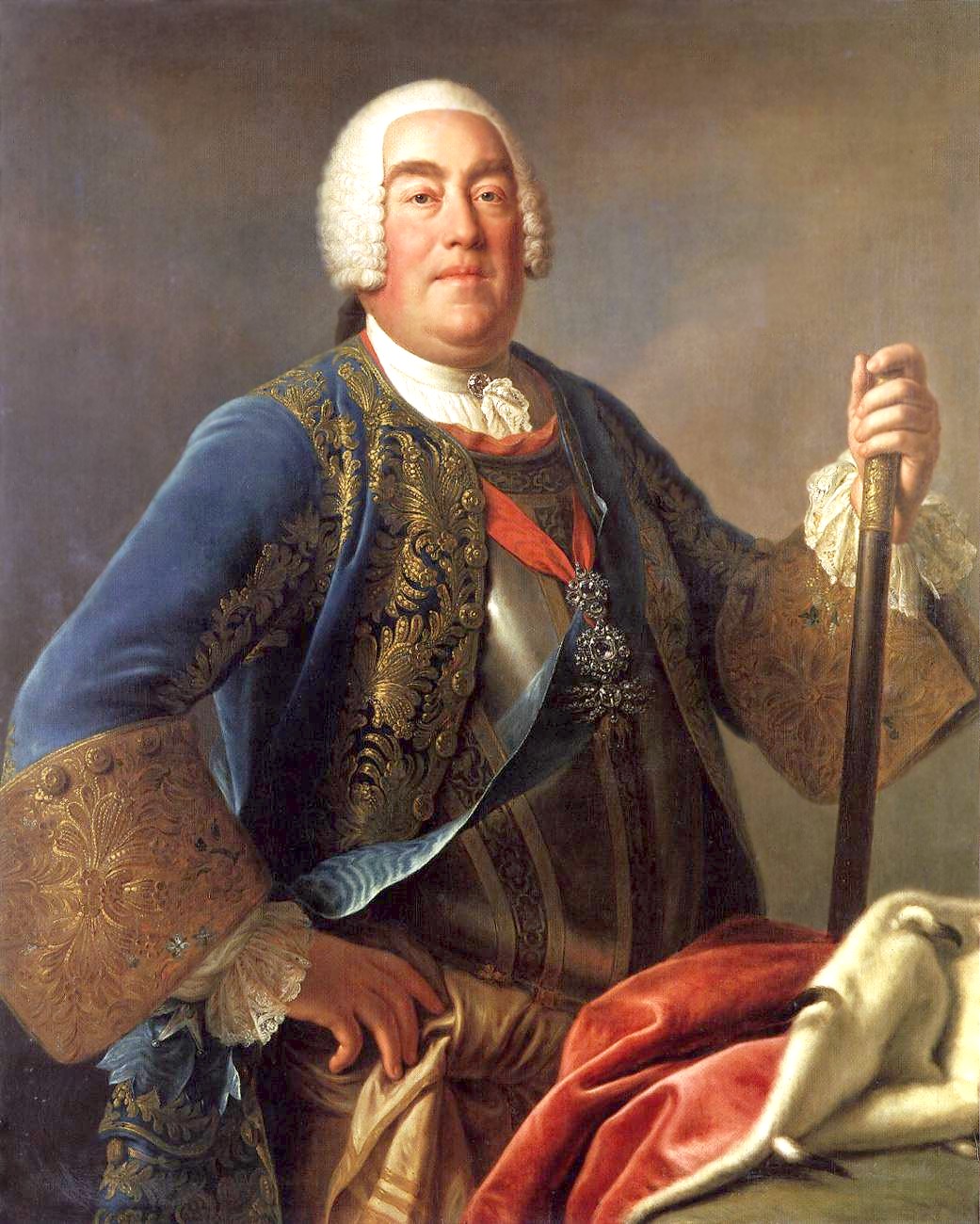|
Preise Dein Glücke, Gesegnetes Sachsen, BWV 215
' (Praise your good fortune, blessed Saxony), BWV 215, is a List of Bach cantatas, secular cantata by Johann Sebastian Bach. He composed the ' (Bach cantata, congratulatory cantata) or ' (drama in music) in Leipzig as a ' (Festive music for the court of the Electorate of Saxony) for the anniversary of the election of Augustus III of Poland, August III, Elector of Saxony, as King of Poland, and first performed it on 5 October 1734 in the presence of the Elector. History and words Bach wrote several works for celebrations of the Leipzig University, ''Festmusiken zu Leipziger Universitätsfeiern''. The ''Neue Bach-Ausgabe'' has detailed background information about the events around the composition and first performance of this cantata, collected by Werner Neumann. Augustus III of Poland, August III, Elector of Saxony and of Poland, had announced his presence in Leipzig from 2 to 6 October 1734, on short notice. As the anniversary of his election as king on 5 October fell dur ... [...More Info...] [...Related Items...] OR: [Wikipedia] [Google] [Baidu] |
Dramma Per Musica
The phrase ''dramma per musica'' (also spelled ''drama per musica''; Italian language, Italian, literally: 'play (or drama) for music', plural: ''drammi per musica'') is commonly found after the title in Italian opera librettos beginning in the 17th century and continuing into the 18th century. It indicates that the text was intended to be set to music by a composer.''The Oxford Dictionary of Opera'' at Internet Archive. By extension it has also been used to refer to the musical setting itself, but this is less common. In the 18th century, ''dramma per musica'' came to be most commonly used for librettos of serious Italian operas, today known as ''opera seria'' (a term that was little-used when they were created), while t ... [...More Info...] [...Related Items...] OR: [Wikipedia] [Google] [Baidu] |
Bach Cantata
The cantatas composed by Johann Sebastian Bach, known as Bach cantatas ( German: ), are a body of work consisting of over 200 surviving independent works, and at least several dozen that are considered lost. As far as known, Bach's earliest cantatas date from 1707, the year he moved to Mühlhausen, although he may have begun composing them at his previous post in Arnstadt. Most of Bach's church cantatas date from his first years as and director of church music in Leipzig, a position which he took up in 1723. Working for Leipzig's and , it was part of Bach's job to perform a church cantata every Sunday and holiday, conducting soloists, the Thomanerchor and orchestra as part of the church service. In his first years in Leipzig, starting after Trinity of 1723, Bach regularly composed a new cantata every week, although some of these cantatas were adapted (at least in part) from work he had composed before his Leipzig era. Works from three annual cycles of cantatas for the l ... [...More Info...] [...Related Items...] OR: [Wikipedia] [Google] [Baidu] |
Aria
In music, an aria (, ; : , ; ''arias'' in common usage; diminutive form: arietta, ; : ariette; in English simply air (music), air) is a self-contained piece for one voice, with or without instrument (music), instrumental or orchestral accompaniment, normally part of a larger work. The typical context for arias is opera, but vocal arias also feature in oratorios and cantatas, or they can be stand-alone concert arias. The term was originally used to refer to any expressive melody, usually, but not always, performed by a singer. Etymology The Italian term ''aria'', which derives from the Greek ἀήρ and Latin ''aer'' (air), first appeared in relation to music in the 14th century when it simply signified a manner or style of singing or playing. By the end of the 16th century, the term 'aria' refers to an instrumental form (cf. Santino Garsi da Parma lute works, ('Aria del Gran Duca'). By the early 16th century, it was in common use as meaning a simple setting of strophe, strophi ... [...More Info...] [...Related Items...] OR: [Wikipedia] [Google] [Baidu] |
Soprano
A soprano () is a type of classical singing voice and has the highest vocal range of all voice types. The soprano's vocal range (using scientific pitch notation) is from approximately middle C (C4) = 261 Hertz, Hz to A5 in Choir, choral music, or to soprano C (C6) or higher in operatic music. In four-part chorale style harmony, the soprano takes the highest part, which often encompasses the melody. The soprano voice type is generally divided into the coloratura soprano, coloratura, soubrette, lyric soprano, lyric, spinto soprano, spinto, and dramatic soprano, dramatic soprano. Etymology The word "soprano" comes from the Italian word ''wikt:sopra, sopra'' (above, over, on top of),"Soprano" ''Encyclopædia Britannica'' as the soprano is the highest pitch human voice, often given to the leading female roles in operas. "Soprano" refers ... [...More Info...] [...Related Items...] OR: [Wikipedia] [Google] [Baidu] |
Gottfried Reiche
Gottfried Reiche (; 5 February 1667 6 October 1734) was a German trumpet player and composer of the Baroque era. Reiche is best known for having been Johann Sebastian Bach's chief trumpeter at Leipzig from Bach's arrival there in 1723 until Reiche's death. Biography Reiche was steeped in trumpet playing from an early age – he was born in the town of Weissenfels, Germany which had a long tradition of trumpet music at its court. He went to Leipzig in 1688, eventually succeeding trumpeter Johann C. Genzmer there as ''Senior Stadtmusicus'' in 1719. Reiche was a musician of great skill, if one can judge from the trumpet parts written for him by Bach. They are among the most florid, creative, and difficult trumpet parts of the Baroque era, quite clearly intended for a player of great virtuosity. He is the subject of a famous painting of the era, which was made by Leipzig artist E.G. Haussmann for the occasion of Reiche's 60th birthday in 1727. In the portrait, Reiche hold ... [...More Info...] [...Related Items...] OR: [Wikipedia] [Google] [Baidu] |
Name Day
In Christianity, a name day is a tradition in many countries of Europe and the Americas, as well as Christian communities elsewhere. It consists of celebrating a day of the year that is associated with one's baptismal name, which is normatively that of a List of biblical names, biblical character or other saint. Where they are popular, individuals celebrate both their name day and their birthday in a given year. The custom originated with the Christian calendar of saints: believers named after a saint would celebrate that saint's feast day. Within Christianity, name days have greater resonance in areas where the Christian denominations of Catholic Church, Catholicism, Lutheranism and Orthodoxy predominate. In some countries, however, name-day celebrations do not have a connection to explicitly Christian traditions. History The celebration of name days has been a tradition in Catholic and Eastern Orthodox countries since the Middle Ages, and has also continued in some measur ... [...More Info...] [...Related Items...] OR: [Wikipedia] [Google] [Baidu] |
Stanisław I Leszczyński
Stanislav and variants may refer to: People *Stanislav (given name), a Slavic given name with many spelling variations (Stanislaus, Stanislas, Stanisław, etc.) Places * Stanislav, Kherson Oblast, a coastal village in Ukraine * Stanislaus County, California * Stanislaus River, California * Stanislaus National Forest, California * Place Stanislas, a square in Nancy, France, World Heritage Site of UNESCO * Saint-Stanislas, Mauricie, Quebec, a Canadian municipality * Stanizlav, a fictional train depot in the game '' TimeSplitters: Future Perfect'' * Stanislau, German name of Ivano-Frankivsk, Ukraine Schools * St. Stanislaus High School, an institution in Bandra, Mumbai, India * St. Stanislaus High School (Detroit) * Collège Stanislas de Paris, an institution in Paris, France * California State University, Stanislaus, a public university in Turlock, CA * St Stanislaus College (Bathurst) St Stanislaus' College is an Australian independent Roman Catholic secondary day and board ... [...More Info...] [...Related Items...] OR: [Wikipedia] [Google] [Baidu] |
Augustus II The Strong
Augustus II the Strong (12 May 1670 – 1 February 1733), was Elector of Saxony from 1694 as well as King of Poland and Grand Duke of Lithuania from 1697 to 1706 and from 1709 until his death in 1733. He belonged to the Albertine branch of the House of Wettin. Augustus' great physical strength earned him the nicknames "the Strong", "the Saxon Hercules" and "Iron-Hand". He liked to show that he lived up to his name by breaking horseshoes with his bare hands and engaging in fox tossing by holding the end of his sling with just one finger while two of the strongest men in his court held the other end.Sacheverell Sitwell. ''The Hunters and the Hunted'', p. 60. Macmillan, 1947. He is also notable for List of people with the most children, fathering a very large number of children, with contemporary sources claiming a total of between 360 and 380. In order to be elected king of the Polish–Lithuanian Commonwealth, Augustus converted to Roman Catholicism. As a Catholic, he received th ... [...More Info...] [...Related Items...] OR: [Wikipedia] [Google] [Baidu] |
Allegory
As a List of narrative techniques, literary device or artistic form, an allegory is a wikt:narrative, narrative or visual representation in which a character, place, or event can be interpreted to represent a meaning with moral or political significance. Authors have used allegory throughout history in all forms of art to illustrate or convey complex ideas and concepts in ways that are comprehensible or striking to its viewers, readers, or listeners. Writers and speakers typically use allegories to convey (semi-) hidden or complex meanings through symbolism (arts), symbolic figures, actions, imagery, or events, which together create the moral, spiritual, or political meaning the author wishes to convey. Many allegories use personification of abstract concepts. Etymology First attested in English in 1382, the word ''allegory'' comes from Latin ''allegoria'', the latinisation (literature), latinisation of the Greek language, Greek ἀλληγορία (''allegoría''), "veiled ... [...More Info...] [...Related Items...] OR: [Wikipedia] [Google] [Baidu] |
Werner Neumann
Werner Neumann (21 January 1905, Königstein – 24 April 1991, Leipzig) was a German musicologist. He founded the Bach-Archiv Leipzig on 20 November 1950 and was a principal editor of the Neue Bach-Ausgabe, the second edition of the complete works of Johann Sebastian Bach. Professional career Neumann studied at the Conservatory of Leipzig from 1928 to 1930, and at the University of Leipzig from 1928 to 1933, besides Musicology also Philosophy, Psychology and Romance studies. He wrote his thesis in 1938 on Bach's choral fugue, "J. S. Bachs Chorfuge. Ein Beitrag zur Kompositionstechnik Bachs". He worked as a teacher from 1934 to 1940 and served the military for five years. From 1945 to 1950 he worked as a freelance teacher, writer on music and teacher at the Musikhochschule Leipzig. After the ''Deutsche Bachfeier 1950'', the bicentennial of Bach, he founded the Bach-Archiv Leipzig for documentation and research, which he presided until 1973, achieving international recogni ... [...More Info...] [...Related Items...] OR: [Wikipedia] [Google] [Baidu] |
Neue Bach-Ausgabe
The New Bach Edition (NBE) (; NBA), is the second complete edition of the music of Johann Sebastian Bach, published by Bärenreiter. The name is short for Johann Sebastian Bach (1685–1750): New Edition of the Complete Works (''Johann Sebastian Bach (1685–1750): Neue Ausgabe sämtlicher Werke''). It is a historical-critical edition (German: ''historisch-kritische Ausgabe'') of Bach's complete works by the Johann Sebastian Bach Institute (Johann-Sebastian-Bach-Institut) in Göttingen and the Bach Archive (Bach-Archiv) in Leipzig, When Bach died most of his work was unpublished. The first complete edition of Bach's music was published in the second half of the nineteenth century by the Bach Gesellschaft ( Bach-Gesellschaft Ausgabe, BGA). The second complete edition includes some discoveries made since 1900, but there are relatively few such scores. The significance of the NBE lies more in its incorporation of the latest scholarship. Although the NBE is an urtext edition rather ... [...More Info...] [...Related Items...] OR: [Wikipedia] [Google] [Baidu] |







